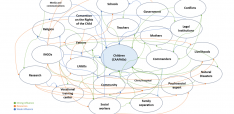‘Trumping’ Let Girls Learn

Getting more girls into school is vital, but it isn’t an answer to poverty and inequality.
In recent weeks there has been uproar about President Trump’s decision to end support for Let Girls Learn—a White House and USAID project that aims to create educational opportunities for girls, particularly in the global South. While I profoundly disagree with the protectionist sentiments that have motivated the administration to reduce funding for this and other similar initiatives, I also see it as an opportunity to re-think the underlying assumptions that inform these kinds of projects in both the South and the North.
Let Girls Learn is the most recent iteration of projects that assume that social issues as wide-ranging as poverty and terrorism can be resolved through education, an approach described as the “educationalization of social problems.” Programs like this one or the Nike Foundation’s Girl Effect posit formal schooling as the primary avenue through which girls can re-shape themselves into ideal citizens who will then be able to address not only their own needs, but also those of their families and communities.
The theory is simple: if girls acquire an education and transform themselves into workers, consumers or entrepreneurs, they will make a larger contribution to the national GDP, and as the economy grows they too will feel its trickle-down effects. It is clear, however —including in the context of the US—that economic gains do not trickle down in this way. Plenty of studies confirm and elaborate on this conclusion. Relying on girls’ education as the ideal or only pathway to resolve issues as complex as poverty is therefore illogical. In fact, evidence shows that schools often reproduce inequalities rather than eradicating them.
In the case of Pakistan where I conduct research, the issue is even more pronounced. The educational system is deeply divided along lines of social class: the elite send their children to grammar or English-medium schools where they pursue British O and A levels, while the poor attend schools with absent teachers and rundown infrastructure. Understandably then, future opportunities for jobs and upward mobility are radically different for each group.
Girls feel this difference keenly. During a recent research trip to Southern Pakistan, I interviewed girls from low-income families about their aspirations after leaving school. Their stories revolved around the limited futures that awaited them. Most girls knew that the jobs they would most likely be able to obtain were at nearby factories, where wages are low and working conditions abhorrent. Others cited examples of educated brothers who could not find paid employment and had to return to work in their families’ fields. These men felt humiliated: “Poe education jo cha faido?”—“What is the benefit of education then?” as 15-year old Meeran said to me in an interview.
In spite of such examples, many girls desire to obtain schooling so that they might be able to obtain white-collar jobs. Eighteen-year-old Rida’s narrative was particularly instructive. She lived in a low-income neighborhood on the outskirts of the city of Hyderabad, and considered schooling to be a lifeline: “I want to get an education also so that I can stand on my own feet…I have extreme interest and desire to get an education… I am willing to give my life for education.”
Rida was well-aware of the lack of job prospects that awaited girls from her social class, but instead of calling on the state to improve the conditions of people like herself she was resigned to this situation: “If it is in my fate, then I will get a job.” Another girl, Nadia (age 17), bemoaned the myriad additional precarities that schooling had introduced into her and her family’s life: “Education is a burden,” she told me, “Whether we have food, housing, or other basic necessities does not matter. Due to education we have to kill our other basic necessities.”
Since when did citizens become responsible for guaranteeing the conditions required for a minimally-decent life? Why should girls like Rida let the state off the hook for its inability to meet the basic needs of its people? Why should they have to give up a meal in order to pay tuition fees for school?
These questions highlight the kind of ‘self-responsibilization’ that underpins programs like Let Girls Learn. It’s a philosophy that sees educated girls as responsible for their own welfare, rather than holding the state accountable for providing the conditions that might enable girls to secure jobs with decent wages and working conditions. Girls like Rida then see their inability to secure a job as their own personal failing.
When we focus on education as the primary pathway to addressing social issues such as poverty, we limit our efficacy considerably. We fail to see the broader range of policies beyond education that must be implemented in order to address poverty and increase the welfare of girls worldwide.
Writing in the context of the United States, historians Harvey Kantor and Robert Lowe have argued that education is not the best anti-poverty program. They call attention to the broad range of redistributive and economic security policies that were put in place during the New Deal, for example. These included increasing the minimum wage, unionization, providing a guaranteed income, and progressive taxation. Such policies must be pursued alongside advocating for girls’ education if the goal is to reduce poverty and inequality.
The Trump administration’s approach to aid and development policy is inspired by a narrow understanding of American self-interest. Gutting programs like Let Girls Learn fits that agenda of protectionism. There’s no doubt that such sentiments should be resisted. At the same time, we have an opportunity to re-imagine policies, projects and advocacy that link girls’ education with broader social and economic goals.
For example, in addition to calling for more support for girls in school, why not institute a higher minimum wage in the US and abroad, or regulate the multinational oil and gas corporations that are engaged in extracting natural resources from Sindh in Pakistan, or end the encroachment of for-profit businesses in directing social policies? Why must Nike Inc. be the ideal partner on girls’ education when there is extensive evidence of its anti-women practices?
Trump’s decision to end Let Girls Learn is shortsighted, but it provides an opportunity to develop a much-needed and deeper conversation about gender and poverty. Let’s not waste it.
Dr. Shenila Khoja-Moolji researches and writes about gender, race, and youth studies. She is currently working on a book that combines historical and cultural studies analyses with ethnographic work to examine the construction of the figure of the ‘educated girl’ in colonial India and postcolonial Pakistan. Follow her on Twitter @SKhojaMoolji. This post first appeared on OpenDemocracy.
Photo credit: Foter.com

